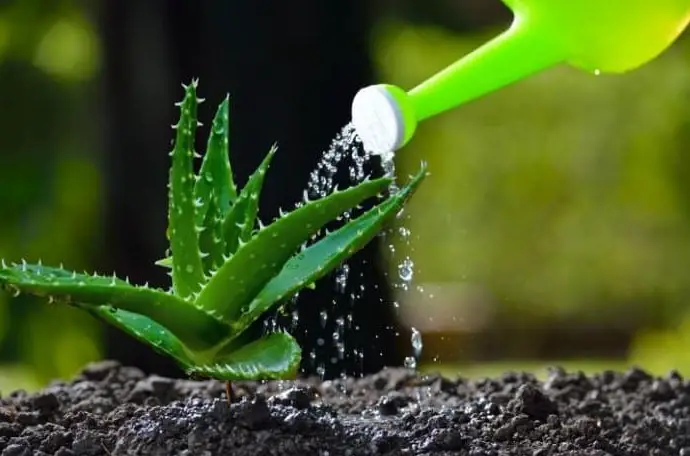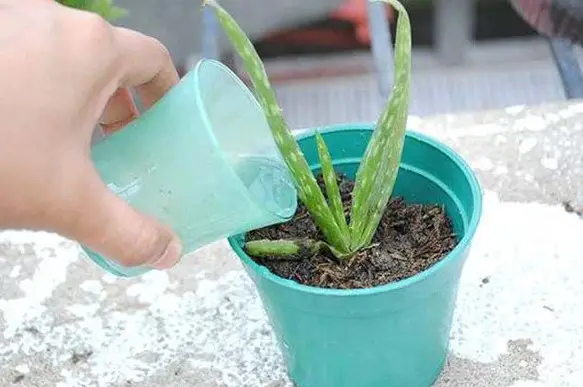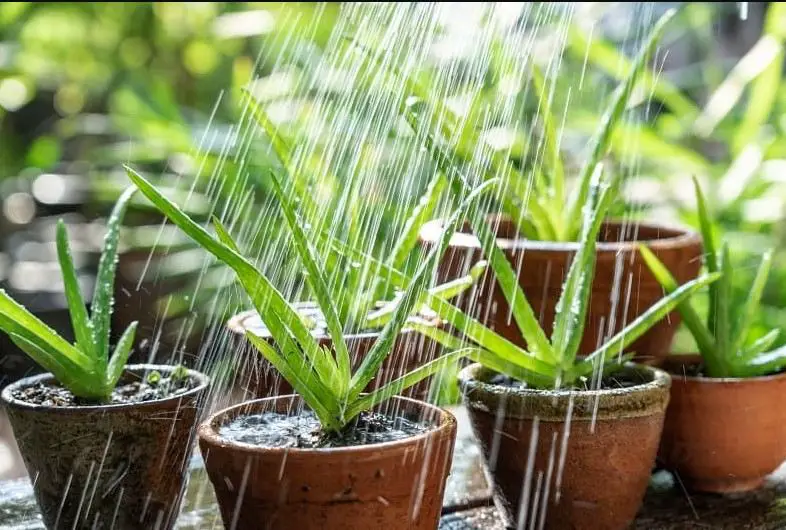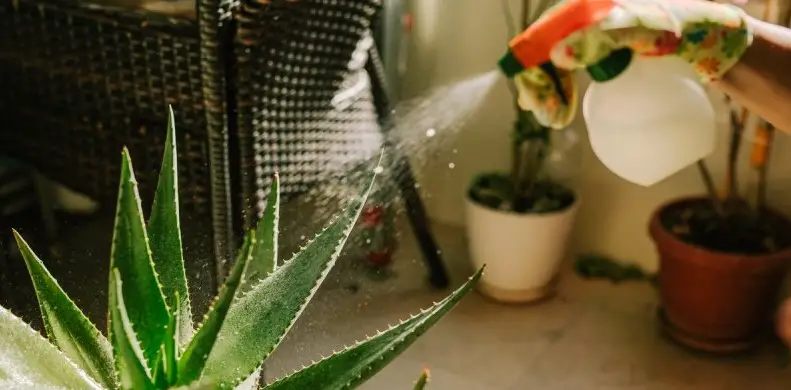The Aloe Vera plant has some amazing health benefits if used correctly. Their thick, plump leaves contain an extremely effective topical and oral gel that can help hydrate skin, ease sunburn symptoms and detoxify the body, to name a few.
It stores the water that it receives to assist in the production of this wonder gel. Aloe vera is succulent, so they don’t require as much water as non-succulent plants.
But do you water aloe vera from top or bottom? This question is asked by countless people, so I have decided to address it in this article.
So the process of watering an aloe vera plant must be done in such a way to allow it to take in as much moisture as possible. Getting it right will ensure your plant stays healthy and happy. This is an important aspect of successfully growing a plant, such as the ever-awesome aloe vera.
With that being said, let’s look deeper into the commonly asked question ‘do you water aloe vera from top or bottom’?

Table of Contents
Do you water aloe vera from top or bottom?
You should always water aloe vera from the bottom. Succulents don’t require much water, but when they do, it’s best to water them so that none goes to waste.
The preferred watering method for a succulent plant is always at the base of the plant’s stem. Pour straight into the soil so the roots can suck the moisture up and store it for later use.
Aim to add the water slowly, so the soil has time to fully soak up the water. Avoid watering the leaves as any water that pools between leaves or other crevices can form rot and mold.
Why do you Water Aloe Vera from the Bottom?
Watering aloe vera at the bottom will increase the chances of its roots soaking in as much moisture as possible. This will allow it to store the water away for use later on.
It’s best to use a sprinkler head on a watering can or something with a fine mist instead of a full-blown gush straight from a hose.

The latter will disturb the soil and possibly cause much larger problems. For example, it may dislodge the whole plant from the soil or break off roots, leading to an early end for the plant. It’s important to note the amount the plant receives also.
Once the water starts to slowly seep out of the drainage holes (if the pot has some), the plant has had enough this time.
Overwatering or underwatering a plant like this can lead to withering and browned tips or even kill the plant. Therefore taking notes is a must!
Why Not Water Aloe Vera Plants from the Top?
The leaves of an aloe vera plant can’t absorb water if poured directly onto them. The roots do all the work below the soil.
Additionally, any moisture left to sit on a leaf or in a crevice of a leaf or stem can slowly rot. Once this sets in, the plant will slowly be eaten away by the rot and turn brown and mushy.

Once the rot reaches this point without being fixed, the plant won’t have much more time left to live. So, watering an aloe vera plant from above or on the top of the plant is just a pointless exercise.
Which Water to Use for Aloe Vera Plants?
As a general rule of thumb, pure distilled water produces more leaves and assists in all-around growth. Succulents tend to be a bit sensitive towards and therefore become better off without those pesky chemicals and minerals that a town water supply can contain.
Chlorine and fluoride and a healthy combination for humans, let alone helpless plants such as the aloe vera.

Hence, using distilled or self-tanked rainwater is much more beneficial and, of course, less harmless. These types of water are tough to compete with regarding cleanliness.
The beauty of these types of water is that you know exactly what goes into them and can test them yourself.
How Much Watering is Needed for Aloe Vera Plants?
In general terms, an aloe vera plant should only be watered once per week. Succulents don’t require frequent watering, and too much moisture can cause issues such as root rot. There are instances where extra watering may be required.
For example, if your plants are located somewhere, they can be exposed to higher than normal amounts of sunlight and extreme heat. If this is the case and you are unsure how to adjust their watering schedule, you can perform a quick touch test.
Simply stick your finger into the soil right beside the plant’s stem. Make sure you push down until your second knuckle reaches the top of the soil. If your finger comes out dry, then watering is necessary.
Cons of Overwatering Aloe Vera Plants with Possible Solutions
If an aloe vera plant is accidentally overwatered, it will cleverly produce some visual signs to show you that it is distressed and needs some attention.
You may find that your plant has either mushy leaves, light/creamy yellow stems and foliage, or the tips of the leaves may even start turning brown. These are sure signs of a rotting root system.

Overwatering can become a problem if the pot doesn’t allow adequate drainage either via drainage holes or the quality of the soil it is growing in.
When this is the case, any excess moisture not utilized by the roots will pool/sit at the bottom of the pot. As the roots are generally located in this area, the roots will be sitting in this pool of water to eventually rot due to the time spent submerged.
In addition, the soil itself can turn to mold if the issue isn’t discovered early and corrected. This lesson is that succulents especially require well-draining soil and pot to ensure that complications like these are minimized.
If you find that your aloe vera plant shows any of these signs, the best thing to do is try to save it.
As long as it is not too far gone, you can:
- Remove the plant from the pot.
- Gently rinse the roots and remove all soil and any decaying matter.
- Cut away any parts of the plant that show signs of disease (Use clean, sterilized tools).
- Add some new soil and nutrients to the plant’s new home.
- Replant the aloe vera.
The beauty of going through this procedure is that your plant gets a restart. It’s a great practice to complete routinely, even if your plant isn’t showing signs of illness. I usually re-pot all of my succulents once a year to allow them to refresh and thrive!
Frequently Asked Questions (fAQs)
What Does an Overwatered Aloe Plant Look Like?
An overwatered aloe vera plant will give you a visual indication of just how sick it has become. If you notice them forming mushy leaves, light/creamy yellow stems and/or foliage, or the tips of the leaves start turning brown; they will need tender, loving care.
What Does an Underwatered Aloe Plant Look Like?
An underwater aloe vera plant can be dangerous to the plant in extreme cases. If this is the case, you will notice droopy, curling, almost placid leaves. Additionally, the potting soil will be bone dry, and the leaves can often turn yellow and form brown blotches on the tips.
How to know when aloe needs water?
The best way to know that your aloe needs water is by doing the knuckle test. Simply stick your finger in the soil down to your second knuckle. Make sure that you push down right beside the stem. If your finger comes out dry, then it’s time to give your plant a drink!
How long can aloe vera go without water?
Since aloe vera is succulent, it can last quite sometime between drinks. An aloe vera plant should be watered once every 1-2 weeks. It’s worth noting, though, that the frequency will depend on specific conditions that can affect the ability to dry the plant out, such as the weather, heat, soil type, etc.
Conclusion:
Aloe vera plants are not only aesthetically pleasing but also reasonably cheap, low maintenance and can pack some handy health benefits to boot. Knowing how to keep them alive is a skill worth mastering.
The best method of watering is definitely at the bottom as that’s where the roots are.
Watering on top will only cause pooling and rot or simply be deemed ineffective. We hope this article has been of some value, and we look forward to producing the next one.


